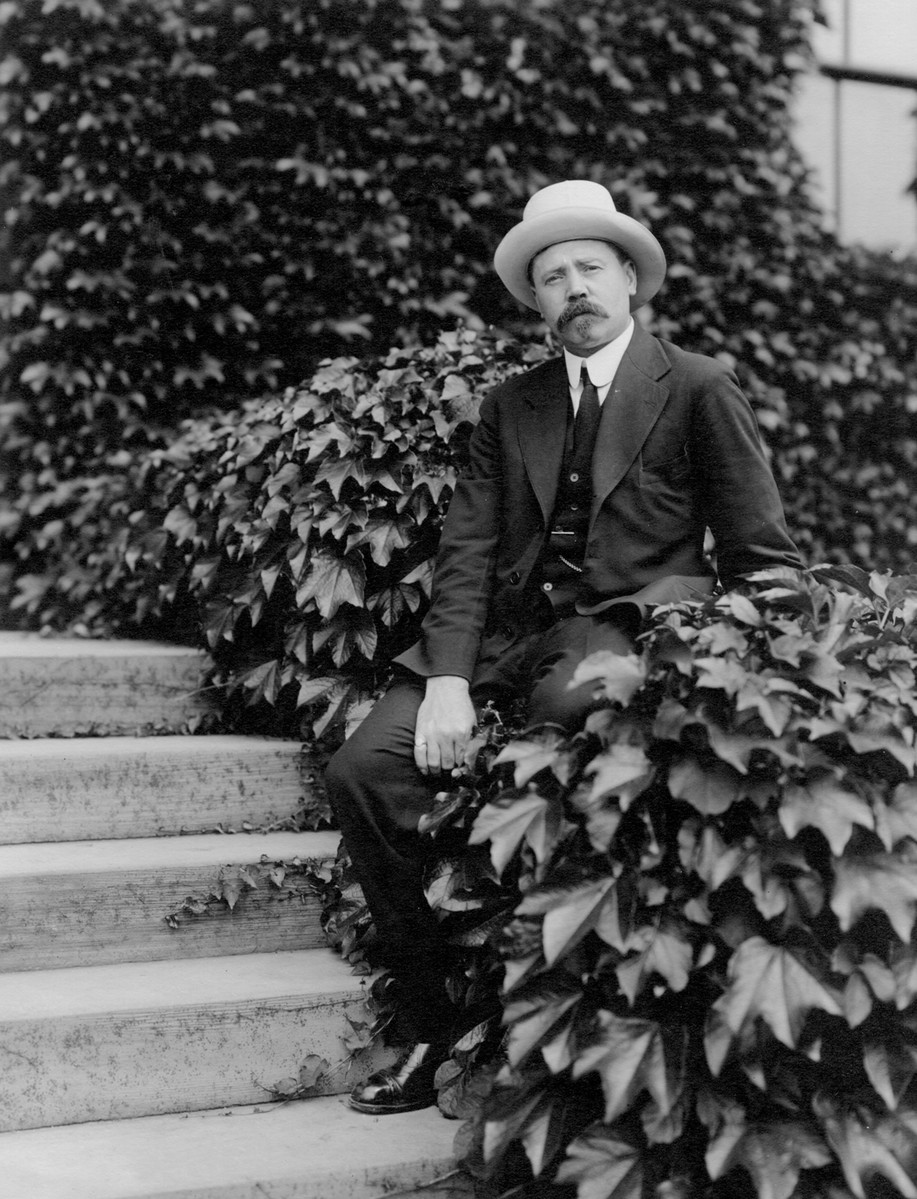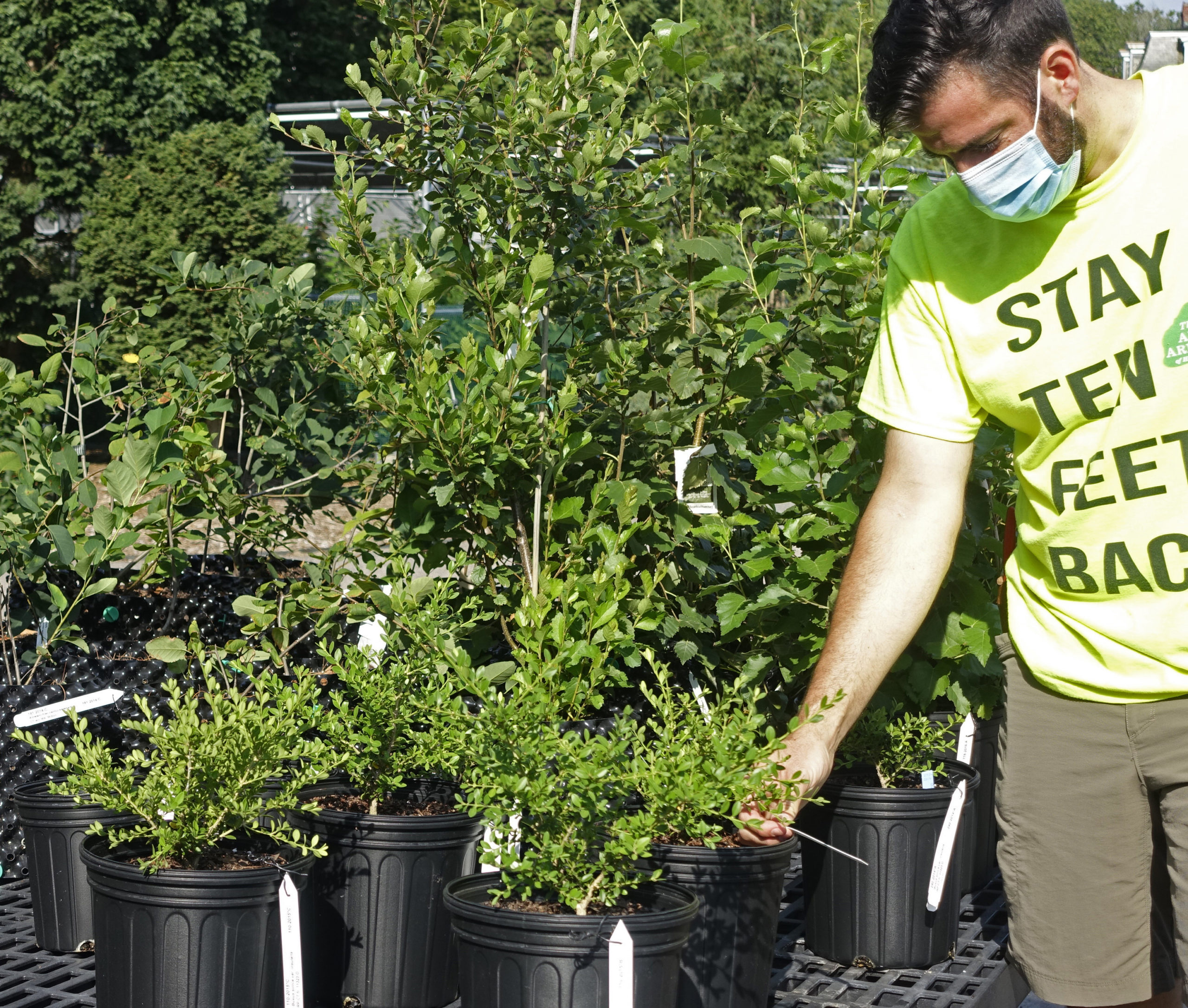Preserving and renewing important plant lineages at the Dana Greenhouses
It was all set in motion on August 15, 2012. During field inventory of accessioned plants in the Explorers Garden on Bussey Hill, Plant Records Manager Kyle Port and Stephanie Stuber, our curatorial fellow at the time, observed the Arnold Arboretum’s signature Korean littleleaf boxwood (Buxus sinica var. insularis, accession 11323*D) in decline: “major deadwood; major lace bug damage.”
This field check note was unfortunately not unique to this broad-leaf evergreen shrub. Previous comments reported a similar sad story. The 1997 April Fool’s Day Blizzard inflicted damage, and Horticulturist Scott Grimshaw noted ten years later that the plant had not only failed to rebound but was continuing its downward trajectory: “steadily declining, mite damage, much dieback.” Shortly after Port and Stuber’s assessment in 2012, Keeper of the Living Collections Michael Dosmann submitted a request for it to be cloned to safeguard against anything equally disastrous befalling the original. Why should this particular plant be repropagated?
This specific Korean littleleaf boxwood happens to be the Arboretum’s oldest living specimen of the plant, collected by renowned plant explorer Ernest Henry Wilson during the ambitious 1917-1919 Expedition to Eastern Asia. Wilson left for the Ryukyu Islands of Japan in January 1917, exploring the flora in Japan for several months, traveling onward to Korea and Japan,
and repeating visits to each before returning to Boston in March 1919. Together with his family, Wilson yielded over 3,000 collections of living plant material and more than 600 photographs during the expedition.

Wilson wrote to director Charles Sprague Sargent at the completion of the two year voyage detailing the shipment process for the bounty:
“There are nineteen cases in all—five plates and fourteen herbarium . . . The Atsuta Maru sails direct to Seattle and will be there before I reach San Francisco, but I expect to be in Boston about the same time as the above cases. The living plants will follow by a later ship as it is too cold this season for them to cross America.”
Ernest Henry Wilson
Wilson noted his great esteem for Korean littleleaf boxwood in his final book:
“If this variety fulfills expectations, it should prove a boon to those who hunger for box edging in regions too cool for the well-being of the European type (B. sempervirens). I count this boxwood one of the most useful plant introductions I was privileged to make in Korea. It came to the Arnold Arboretum in 1918, and so far has never suffered any winter injury.”
Ernest Henry Wilson, If I Were to Make a Garden (1931)
As Wilson stated, Korean littleleaf boxwood is well regarded for its exceptional cold hardiness. The cultivars ‘Nana’ and ‘Wintergreen’ in particular, as well as the straight species, are highly desired in the landscape industry. Plants range from 1.5 to 7 feet tall, with an upright, loose habit and subtly arching branches. Glossy evergreen foliage makes it the ideal selection for hedges and shrub borders. It differs from the more ubiquitous common boxwood (B. sempervirens) by its significantly smaller elliptic (oval) leaves and from B. microphylla in its slightly pubescent branches.

Wilson also remarked that this small shrub “propagates with the greatest of ease,” a lucky break for former plant propagator Jack Alexander III who received the clone request from Dosmann in 2012. Alexander harvested 30 stem cuttings on July 31, 2014 and again the following year on June 16, just to be certain that the Arboretum had a suitable number of duplicates of this VIP (very important plant).
Coincidentally in both attempts, seven of the thirty cuttings successfully sent out adventitious roots and were subsequently transplanted into containers of potting soil. Plants have been dutifully nurtured at the Dana Greenhouses, and presently, one plant remains from the 2014 attempt (the other six were offered to collaborating public gardens). This individual along with the seven plants resulting from the 2015 effort will be placed in their permanent locations in our landscape next spring. Sean Halloran, our current plant propagator, has marked Dosmann’s 2012 request as complete, and this crucial centenarian lineage is now fully secure.
Until sites in the Arboretum landscape are selected for these new clones, the original introduction of Korean littleleaf boxwood to the West can still be viewed along Chinese Path in the Explorers Garden. In fact, over one hundred years later, nearly 40 of Wilson’s 1917-1919 acquisitions are flourishing in the landscape. Royal azalea (Rhododendron schilippenbachii, accession 13432*MASS) and Japanese stewartia (Stewartia pseduocamellia, accession 11440*A and *B), both collected in the Republic of Korea, are growing near their native compatriot Korean littleleaf boxwood in the Explorers Garden. Near the Ponds, Japanese yellowwood (Platyosprion platycarpum, accession 10928*A) and Malus spontanea (accession 10796*A), also hailing from Japan, still grab attention.

Korean littleleaf boxwood is not the only shrub that Halloran and others on our staff are replicating—more than 200 extraordinary plants are currently in the queue. The Campaign for the Living Collections, our ten-year plant exploration and collection initiative, is on track to add nearly 400 new taxa primarily through wild-collected seed. Equally important is ensuring that our historical lineages are protected and preserved for study and enjoyment long into the future. As the Arboretum nears its sesquicentennial in 2022, a steady stream of clones tied to our long history of exploration and introduction will transition to our landscape, giving new life and adding new chapters to our most storied plants.
From “free” to “friend”…
Established in 1911 as the Bulletin of Popular Information, Arnoldia has long been a definitive forum for conversations about temperate woody plants and their landscapes. In 2022, we rolled out a new vision for the magazine as a vigorous forum for tales of plant exploration, behind-the-scenes glimpses of botanical research, and deep dives into the history of gardens, landscapes, and science. The new Arnoldia includes poetry, visual art, and literary essays, following the human imagination wherever it entangles with trees.
It takes resources to gather and nurture these new voices, and we depend on the support of our member-subscribers to make it possible. But membership means more: by becoming a member of the Arnold Arboretum, you help to keep our collection vibrant and our research and educational mission active. Through the pages of Arnoldia, you can take part in the life of this free-to-all landscape whether you live next door or an ocean away.

